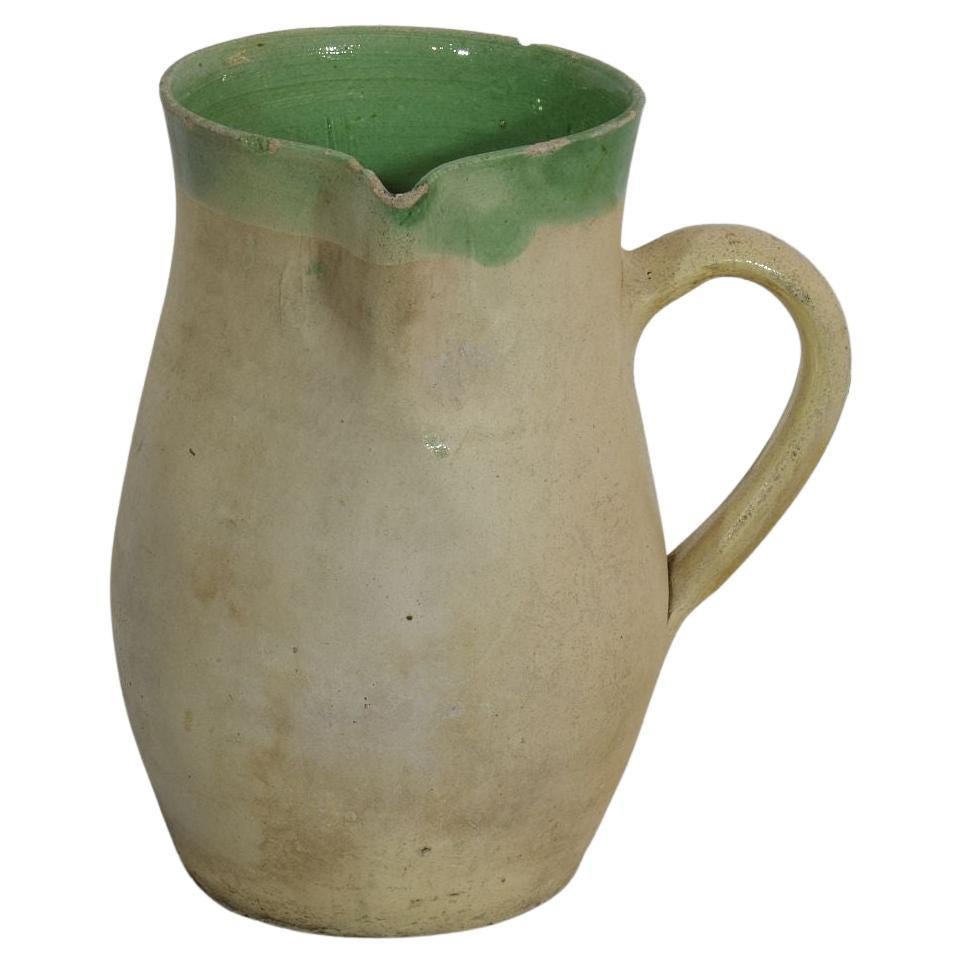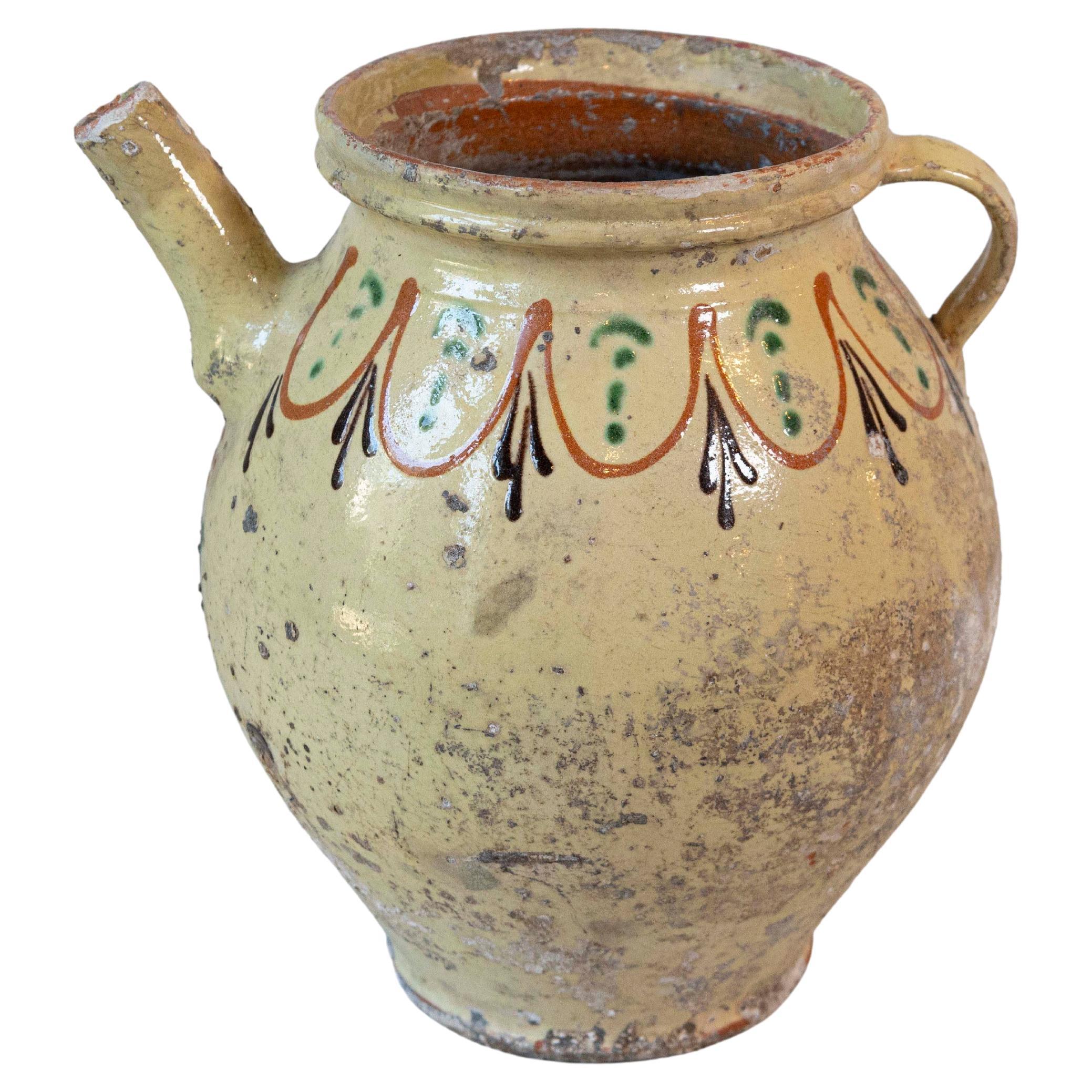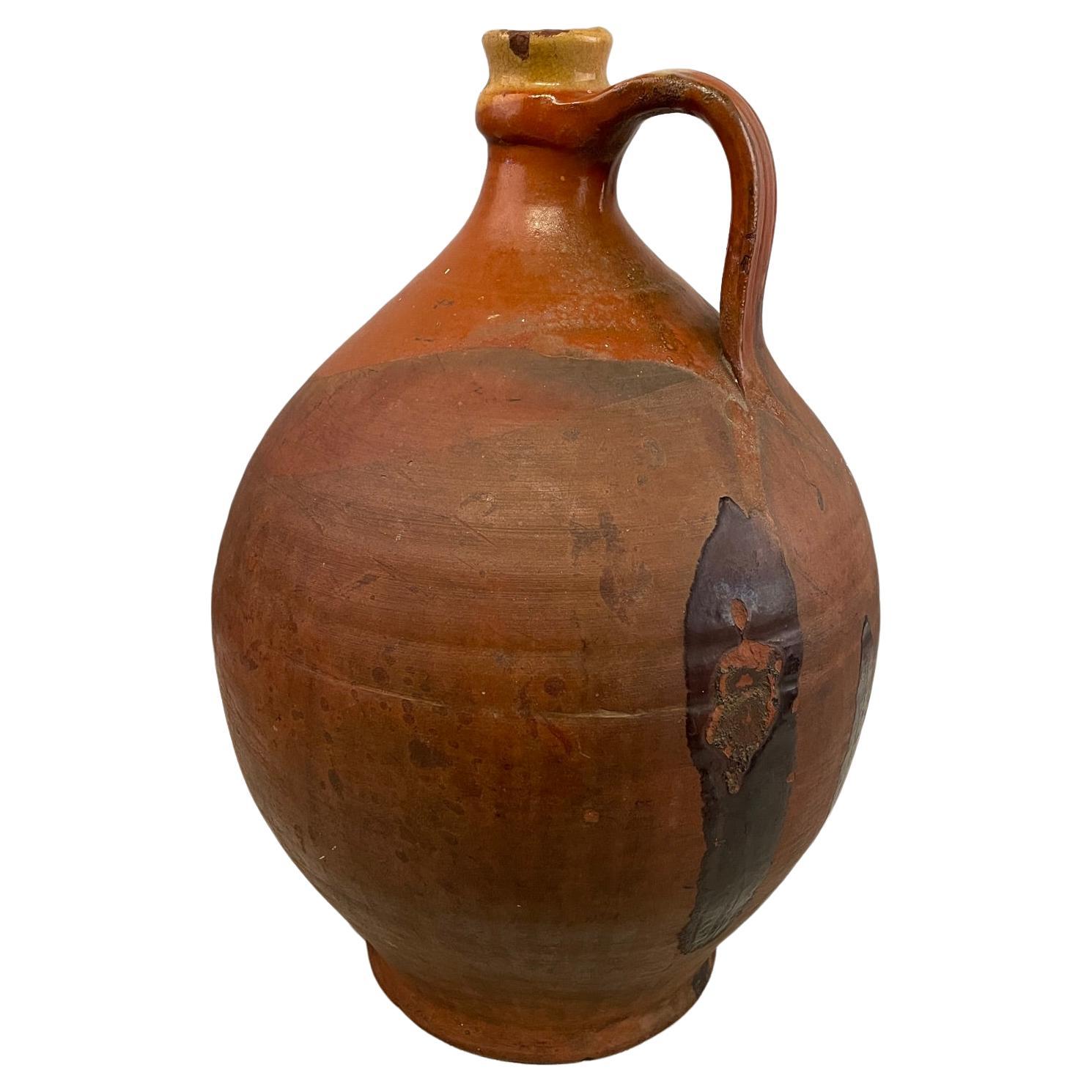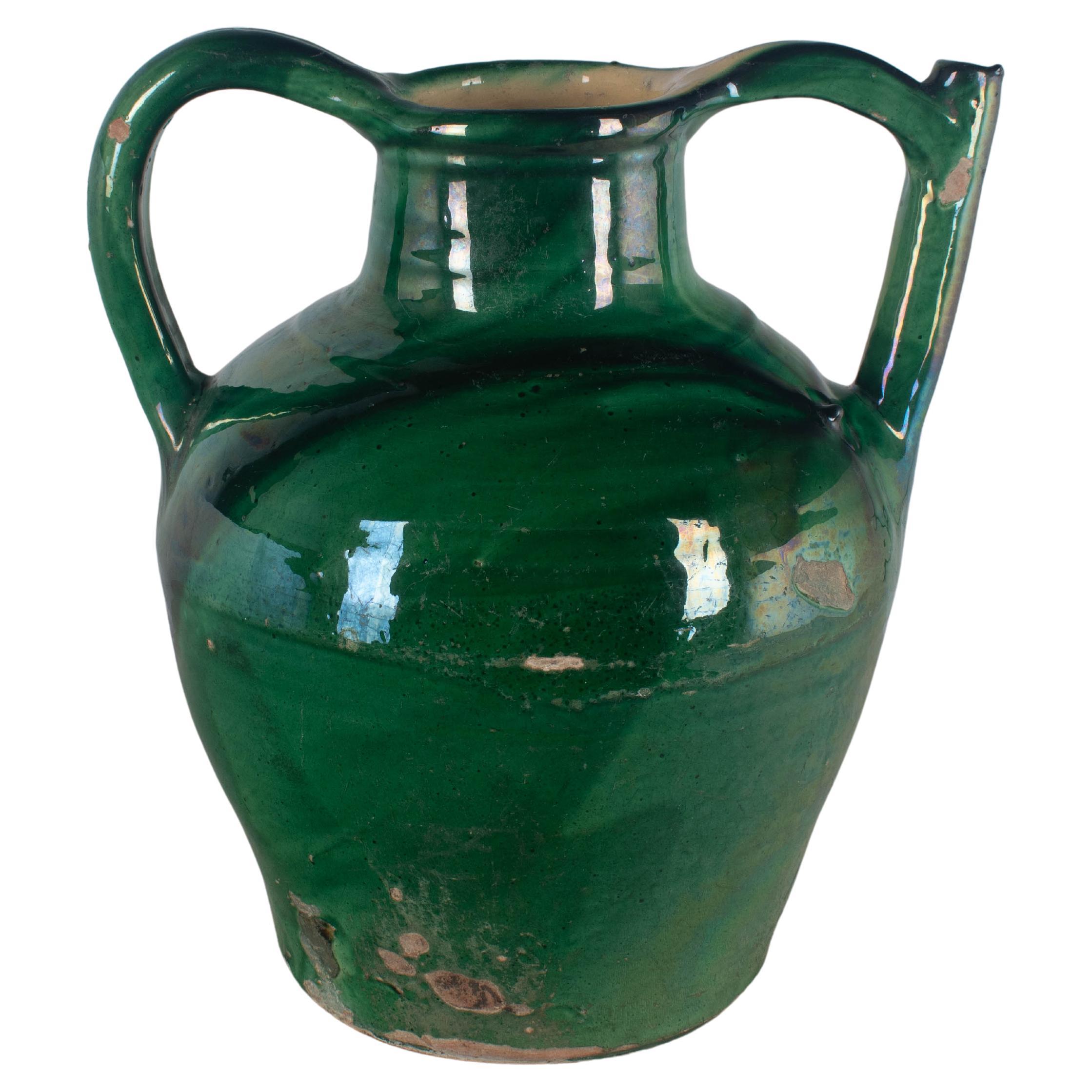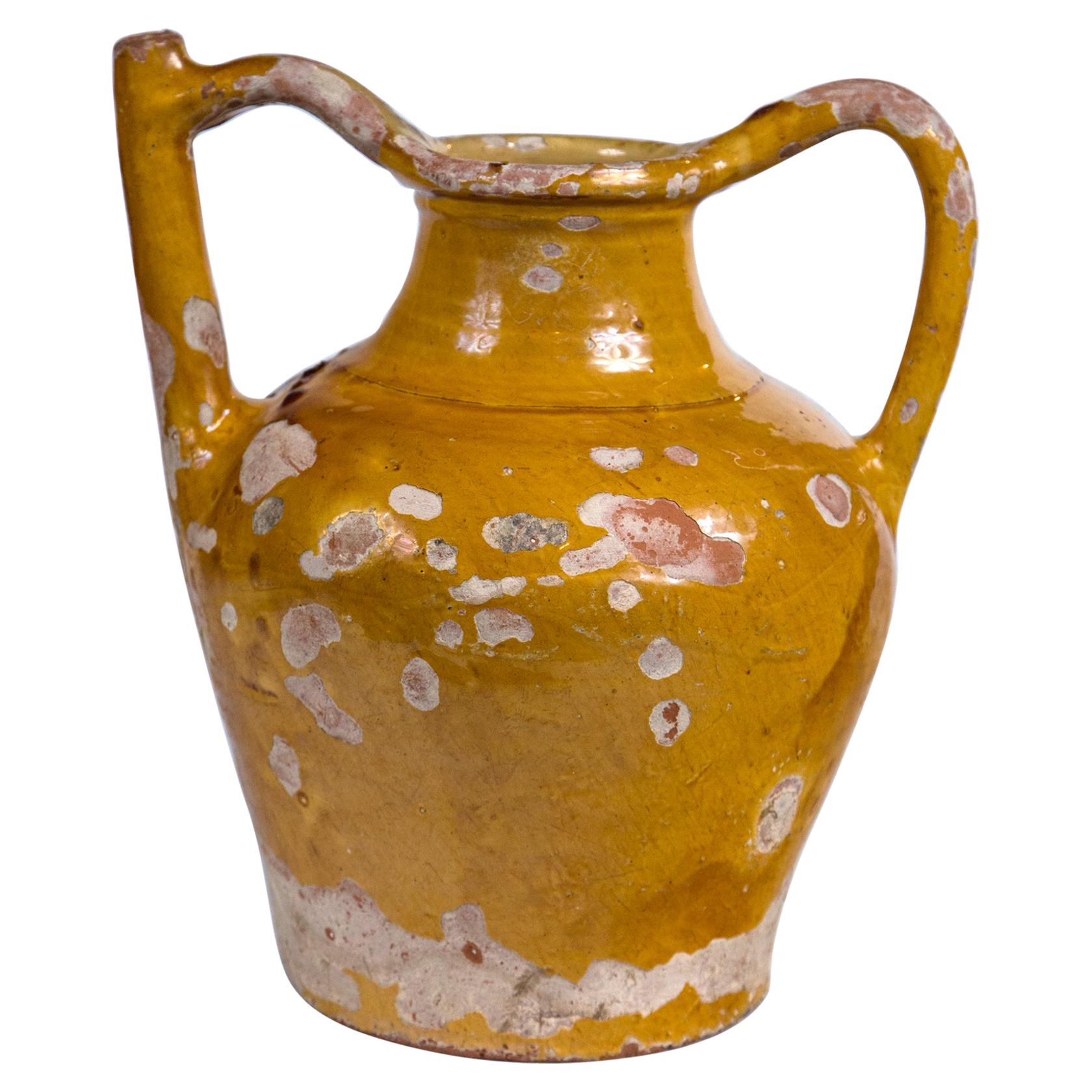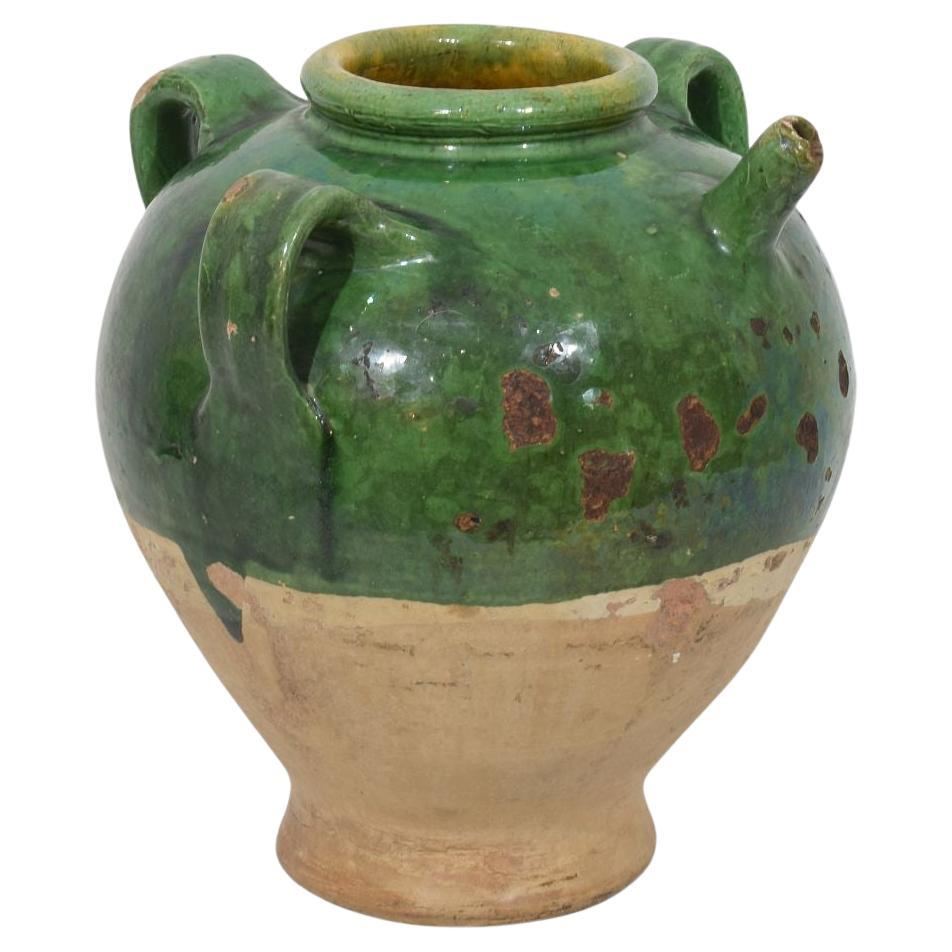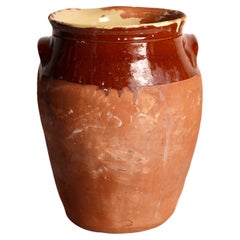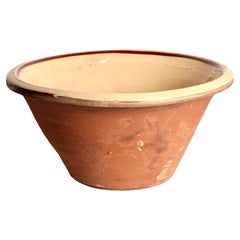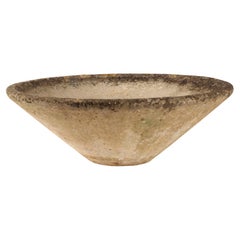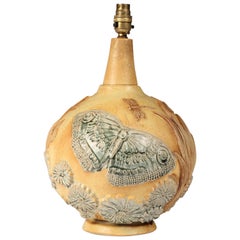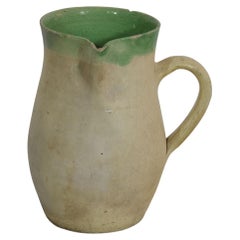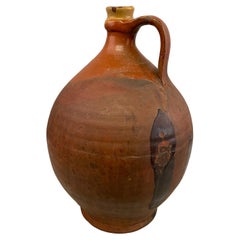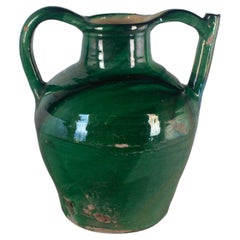Items Similar to Antique French Glazed Terracotta Water Spout Jug - Authentic Southern France
Want more images or videos?
Request additional images or videos from the seller
1 of 7
Antique French Glazed Terracotta Water Spout Jug - Authentic Southern France
$488.72
£360
€422.03
CA$672.97
A$753.18
CHF 394.26
MX$9,149.75
NOK 5,006.12
SEK 4,724.13
DKK 3,149.10
About the Item
Antique French Glazed Terracotta Water Spout Jug - Authentic Southern France
This rare antique French glazed terracotta water spout handle jug is a unique and authentic piece from Southern France, rich with history and character. What sets this jug apart is its original condition, complete with natural chips and imperfections that showcase its age and provenance. The wear on the green glaze has revealed the underlying terracotta, creating visually interesting textures and patterns that add to its charm and authenticity.
Valued for both its historical and decorative significance, this rare terracotta jug is a must-have for collectors of antique French pottery or those seeking genuine rustic décor. The jug's weathered look, developed over years of use, gives it a unique patina that enhances its overall appeal. Comparable to traditional French confit pots, it showcases a craftsmanship that reflects the rich heritage of the South of France. This piece is perfect for adding an element of history and artistry to your home or collection.
The jug is in good antique condition, with wear that contributes to its overall character without compromising its structural integrity. Potential buyers will appreciate the natural aging and surface losses, which enhance its one-of-a-kind look. Whether displayed as a decorative item or put to practical use, this water spout jug is a beautiful example of French craftsmanship. Its rarity, unique condition, and connection to French history make it an extraordinary addition to any space or collection.
We invite you to follow us and look at our Storefront for further 20th Century Design and 19th Century pieces. General note: Shipping quotes, as supplied by 1stdibs, are only indicative. Please contact us directly with your shipping requirements and we will source the most competitive shipment method (and rate) for every individual piece.
- Dimensions:Height: 12.6 in (32 cm)Diameter: 9.45 in (24 cm)
- Style:French Provincial (Of the Period)
- Materials and Techniques:
- Place of Origin:
- Period:
- Date of Manufacture:1800s
- Condition:Wear consistent with age and use. Minor losses. Minor structural damages. Minor fading. Interior Diameter of neck is 8.1cm Diameter of neck 10.3cm height to top of neck.
- Seller Location:London, GB
- Reference Number:Seller: No.51stDibs: LU286838882793
About the Seller
5.0
Platinum Seller
Premium sellers with a 4.7+ rating and 24-hour response times
Established in 2015
1stDibs seller since 2017
194 sales on 1stDibs
Typical response time: 1 hour
- ShippingRetrieving quote...Shipping from: Maldon, United Kingdom
- Return Policy
Authenticity Guarantee
In the unlikely event there’s an issue with an item’s authenticity, contact us within 1 year for a full refund. DetailsMoney-Back Guarantee
If your item is not as described, is damaged in transit, or does not arrive, contact us within 7 days for a full refund. Details24-Hour Cancellation
You have a 24-hour grace period in which to reconsider your purchase, with no questions asked.Vetted Professional Sellers
Our world-class sellers must adhere to strict standards for service and quality, maintaining the integrity of our listings.Price-Match Guarantee
If you find that a seller listed the same item for a lower price elsewhere, we’ll match it.Trusted Global Delivery
Our best-in-class carrier network provides specialized shipping options worldwide, including custom delivery.More From This Seller
View All19th Century Oversized Twin-Handled Dairy Jug – English Heritage Craftsmanship
Located in London, GB
19th Century Oversized Twin-Handled Dairy Jug – English Heritage Craftsmanship
---
This wonderful oversized twin-handled 19th-century dairy jug embodies th...
Category
Antique 1890s English Country Garniture
Materials
Clay, Terracotta
A large English 19th Century Dairy Bowl from The Cotswolds
Located in London, GB
This wonderful over sized 19th Century Dairy Bowl was found in the darkest depths of The historic Cotswolds in England. A Hand made Dairy Bowl that we procured from a traditional che...
Category
Antique 1890s English Country Decorative Bowls
Materials
Pottery, Terracotta
Willy Guhl Inspired Concrete Planter in Cone Shape Made in England, 1960’s
By Willy Guhl
Located in London, GB
Mid-Century Modern Concrete Planter – 1960s English Design
Discover this exquisite Mid-Century Modern concrete planter from England, dating ba...
Category
Vintage 1960s English Mid-Century Modern Planters, Cachepots and Jardini...
Materials
Concrete
Mid-Century Modern Brutalist Ceramic Table Lamp by Bernard Rooke
By Bernard Rooke
Located in London, GB
An organic and Brutalist style Butterly table lamp. No chips or cracks. Easily retired for all regions.
Bernard Rooke (born 1938) is a British artist and studio potter. Rooke has exhibited his "Brutalist" ceramics and painting both in the UK and abroad with work in many collections both public and private including the Victoria and Albert Museum, Cleveland Museum of Art, Nuffield Foundation, Röhsska Museum in Sweden and the Trondheim Kunstmuseum in Norway.
Bernard Rooke attended Ipswich School of Art studying painting and lithography before going on to study at Goldsmiths College of Art. It was while studying here that he decided to take up pottery. Although unfamiliar with this craft and tradition, he found that working with clay provided new opportunities for freedom of interpretation and creativity.
In 1960 Rooke set up his first pottery in Forest Hill in South London along with Alan Wallwork. It was a very small room with enough space for a small electric kiln. He was initially using mainly hand building, coiling, blocking and slabbing techniques. While researching ideas, he was supporting himself by part-time lecturing at London University, Goldsmiths College and St Mary's College. In addition, Rooke's membership of 'The Craftsman Potters' Association' enabled him to show his work in a shop in Carnaby Street in London.
In 1967, both the need for a larger working space and becoming disillusioned with living in London spurred Rooke into moving out of the city and to an old mill building in Swilland in Suffolk. Rooke wanted to widen the range of work so as to become more commercial. With the birth of his son, Aaron, and much needed work to be done on the mill, it was important to be able to make a living.
In 1968, the Grand Metropolitan Hotel commissioned Rooke to make 120 standard lamps, 120 table lamps as well as a 24 foot long ceramic mural and another 9 foot high, which incorporated interior lighting. The money from the commission helped to pay for much needed restoration work on the mill.
By the 1970s, a gallery space was opened in the windmill and run by Susan Rooke, Bernard's wife, selling work to locals and tourists as well as to American airmen based nearby. The vision for Mill Gallery was beginning to develop and alongside this a reputation was building bringing in a good source of income.
Sons Aaron and Felix were becoming more involved with the running of the pottery, giving Bernard more time to develop new ideas and designs and more time to continue with his painting. In 2004, the Rooke family decided not to sell to the public through the gallery anymore and close the pottery to concentrate more on painting and printmaking.
In 2017 Bernard's lighting was featured in the Exhibition: “Glass, Light, Paint & Clay” at the Peterborough Museum and Art Gallery. The exhibition featured four artists: Bernard Rooke, John Maltby...
Category
Vintage 1970s English Brutalist Table Lamps
Materials
Clay
1930’s Belgium Ceramic Basket Casserole with Vegetable and Mushroom Lid
Located in London, GB
A wonderful Casserole bowl or dish with integral lid, produced in Belgium, circa 1930. A ‘Tellurite’ model number -1125- lidded tureen with basket weave sides in rich, deep earth ton...
Category
Vintage 1930s Belgian Pottery
Materials
Ceramic, Pottery
Mid Century Modern Ceramic Jardinière by Bernard Rooke
By Bernard Rooke
Located in London, GB
An organic and Brutalist style Jardine which would work perfectly with trailing foliage.
Bernard Rooke (born 1938) is a British artist and studio potter. Rooke has exhibited his "Brutalist" ceramics and painting both in the UK and abroad with work in many collections both public and private including the Victoria and Albert Museum, Cleveland Museum of Art, Nuffield Foundation, Röhsska Museum in Sweden and the Trondheim Kunstmuseum in Norway.
Bernard Rooke attended Ipswich School of Art studying painting and lithography before going on to study at Goldsmiths College of Art. It was while studying here that he decided to take up pottery. Although unfamiliar with this craft and tradition, he found that working with clay provided new opportunities for freedom of interpretation and creativity.
In 1960 Rooke set up his first pottery in Forest Hill in South London along with Alan Wallwork. It was a very small room with enough space for a small electric kiln. He was initially using mainly hand building, coiling, blocking and slabbing techniques. While researching ideas, he was supporting himself by part-time lecturing at London University, Goldsmiths College and St Mary's College. In addition, Rooke's membership of 'The Craftsman Potters' Association' enabled him to show his work in a shop in Carnaby Street in London.
In 1967, both the need for a larger working space and becoming disillusioned with living in London spurred Rooke into moving out of the city and to an old mill building in Swilland in Suffolk. Rooke wanted to widen the range of work so as to become more commercial. With the birth of his son, Aaron, and much needed work to be done on the mill, it was important to be able to make a living.
In 1968, the Grand Metropolitan Hotel commissioned Rooke to make 120 standard lamps, 120 table lamps as well as a 24 foot long ceramic mural and another 9 foot high, which incorporated interior lighting. The money from the commission helped to pay for much needed restoration work on the mill.
By the 1970s, a gallery space was opened in the windmill and run by Susan Rooke, Bernard's wife, selling work to locals and tourists as well as to American airmen based nearby. The vision for Mill Gallery was beginning to develop and alongside this a reputation was building bringing in a good source of income.
Sons Aaron and Felix were becoming more involved with the running of the pottery, giving Bernard more time to develop new ideas and designs and more time to continue with his painting. In 2004, the Rooke family decided not to sell to the public through the gallery anymore and close the pottery to concentrate more on painting and printmaking.
In 2017 Bernard's lighting was featured in the Exhibition: “Glass, Light, Paint & Clay” at the Peterborough Museum and Art Gallery. The exhibition featured four artists: Bernard Rooke, John Maltby...
Category
Vintage 1970s English Brutalist Planters and Jardinieres
Materials
Clay
You May Also Like
19th Century, French Glazed Earthenware Water Jug
Located in Buisson, FR
Great authentic and rare piece of pottery from the Provence. Beautiful weathered and an amazing color. Imperfections help authenticate this water cruche as it was an utilitarian type...
Category
Antique 19th Century French French Provincial Ceramics
Materials
Earthenware
$289 Sale Price
42% Off
French 19th Century Rustic Glazed Pottery Olive Oil Pot with Polychrome Motifs
Located in Atlanta, GA
A French glazed pottery olive oil pot from the 19th century, with brown, orange and green motifs. Created in France during the 19th century, this rustic ...
Category
Antique 19th Century French Rustic Pitchers
Materials
Pottery
Early 19th Century French Terracotta Water Jug
Located in Winter Park, FL
A French Terracotta Pottery water jug with some glazing near the top. Great color and it weighs 9 Lbs. Dimensions are 15" high by 10" diameter.
Circa 1820-1840. In Good condition wi...
Category
Antique Early 19th Century European French Provincial Pottery
Materials
Terracotta
Early 20th Century Green Glazed Water Jug from France 14"High
Located in Winter Park, FL
An early 20th century green glazed terracotta vinegar or water jug from the Southwest of France with spout in the handle. Beautiful green color. Chips and losses to glaze. Circa 1900...
Category
Early 20th Century French French Provincial Pottery
Materials
Terracotta
French Terracotta Water Pitcher 'Gargoulette', 19th Century
Located in Chappaqua, NY
French terracotta water pitcher (Gargoulette), 19th century. A wonderful and rare piece of pottery. The double handled design was for serving water at the table. Traditional mustard ...
Category
Antique Mid-19th Century French French Provincial Pitchers
Materials
Terracotta
French 19th Century Glazed Earthenware Walnut Oil Jug
Located in Buisson, FR
French walnut oil jug from the Southern part of France around Castelnaudary.
An extremely rare large three-handled green-glazed earthenware storage vessel, with pouring spout. Almos...
Category
Antique 19th Century French French Provincial Ceramics
Materials
Earthenware
$502 Sale Price
46% Off
More Ways To Browse
Green Glazed Jugs
Silver Water Pot
French Green Jug
Antique Clay Jug Jugs
Antique Terracotta Jug
Clay Water Jug
White Hen On Nest
17th Century Islamic Pottery
Agate Teapot
Antique Puzzle Jugs
Bull Baiting
Creamware Chestnut
Creamware Mug
Matte Oil Pottery Large
Mexican Clay Pot With Handle
Mocha Creamware
Mocha Mug
Puzzle Jug
